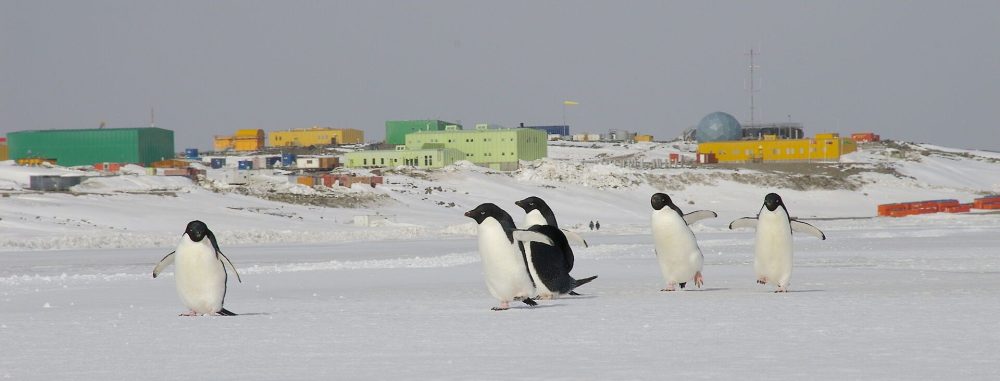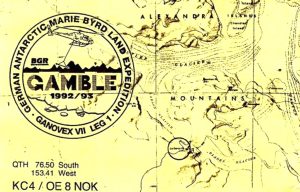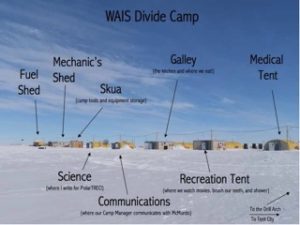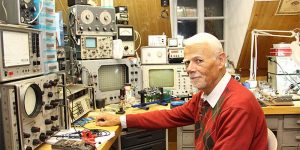 |
The seventh German Antarctic North Victoria Land Expedition (GANOVEX VII) took place in the austral summer of 1992/93.
 GANOVEX VII Multinational expedition was again funded by the Federal Agency for Geosciences and Natural Resources (BGR). Expedition leader was Dr. Roland, the ship “PolarQueen” was used, researchers from the various institutes BGR, AWI, DLR, Uni Frankfurt/M and others as well as from Holland, USA and New Zealand were involved, the Americans and a team from Australia took care of the helicopter service.
GANOVEX VII Multinational expedition was again funded by the Federal Agency for Geosciences and Natural Resources (BGR). Expedition leader was Dr. Roland, the ship “PolarQueen” was used, researchers from the various institutes BGR, AWI, DLR, Uni Frankfurt/M and others as well as from Holland, USA and New Zealand were involved, the Americans and a team from Australia took care of the helicopter service.
During GANOVEX VII, Geological and geophysical investigations were carried out on both sides of the Ross Sea: on King Edward VII Peninsula, Marie Byrd Land, in the east, and in Northern Victoria Land and the adjacent Oates Coast in the West.
See: Geology and Geophysics of Marie Byrd Land, Northern Victoria Land, and Oates Coast. GANOVEX VII — Schweizerbart science publishers
For the first time, BGR also carried out research in the GANOVEX Marie-Byrd-Land, Project GAMBLE in the Camp “La Gorce” at 76°50’ South, 153°41’ West; radio operator was Werner Thonhauser, OE8NOK Austrian radio operator and electronics technician during Ganovex I to VII, signing KC4/OE8NOK.
Marie Byrd Land hosted the Operation Deep Freeze base Byrd Station (originally at 80°S, 120°W, rebuilt at 80°S, 119°W), beginning in 1957, in the hinterland of Bakutis Coast. Byrd Station (WAP USA-19) was the only major base in the interior of West Antarctica for many years. In 1968, the first ice core to fully penetrate the Antarctic Ice Sheet was drilled here. The year-round station was abandoned in 1972, and after operating for years as a temporary summer encampment, Byrd Surface Camp (WAP USA-20),
Byrd Station (WAP USA-19), was reopened by the United States Antarctic Program (USAP) in 2009–2010 to support operations in northern West Antarctica. USA did set another large number of Camps at Marie Bird Land, (Bentley camps, J-9 Bern camp, Orset D Camp, Reedy Glacier Camp, Tam Camp, Taylor Camp and Twaites Camp, all listed on WAP-WADA Directory as USA-NEW.
Ham Radio activity from all the USA Stations & Camps on Marie Bird Land have been referenced on WAP-WADA Directory (See: WAP USA-Ø3, Ø4, 14, 18, 19, 2Ø, 3Ø, 35, 41 and 45).
On Ruppert Coast of Marie Byrd Land is the Russian station Russkaya (WAP RUS-12), which was occupied 1980–1990 and now closed East of the Siple Coast off the Ross Ice Shelf, Siple Dome Camp (WAP USA-18) was established as a summer science camp in 1996. Ice cores have been drilled here to retrieve the climate history of the last 100,000 years. This camp also served as a base for airborne geophysical surveys supported by the University of Texas Insistute for Geophisics (UTIG).
In 1998–1999, East Camp (WAP USA-32) was operated at the Ford Ranges (FRD) in western Marie Byrd Land, supporting a part of a United States Antarctic Program (USAP) airborne survey initiated by UCSB and supported by the UTIG flying out of Siple Dome (WAP USA-18).
In 2004–05, a large Camp Thwaites (THW),  WAP USA-NEW, was established by the USAP 150 km (93 mi) north of NBY, in order to support a large airborne geophysical survey of eastern Marie Byrd Land by the UTIG.
WAP USA-NEW, was established by the USAP 150 km (93 mi) north of NBY, in order to support a large airborne geophysical survey of eastern Marie Byrd Land by the UTIG.
In 2006, a major encampment WAIS Divide (WSD) WAP USA-24 (Pic on the Right) was established on the divide between the Ross Sea Embaymnent and the Amundsen Sea Embayment, in easternmost Marie Byrd Land, in order to drill a high resolution ice core. Drilling and coring ended in 2014
 About Werner Thonhauser, OE8NOK (pic aside), he is now retired. He was ship electrical engineer and electronics technician, radio amateur, as reported on his professional career, his worldwide seafaring, his activities in the Antarctic, and the state of the art of communication technology at that time.
About Werner Thonhauser, OE8NOK (pic aside), he is now retired. He was ship electrical engineer and electronics technician, radio amateur, as reported on his professional career, his worldwide seafaring, his activities in the Antarctic, and the state of the art of communication technology at that time.
Training in Austria and Germany. Stations in Wolfsberg, Villach, Munich, Bremerhafen, Bremen. Education at the University of Applied Sciences Oldenburg, Department of Maritime Affairs.
Until 1980 he served as a radio officer on various ships, in 1979 for the first time with the destination Antarctica. 1981-1996 radio officer and electronics technician on board the research vessel POLARSTERN.
For 7-fold participation in GANOVEX Antarctic expeditions for the Federal Institute for Geosciences and Natural Resources released as radio officer. Assignment for the “Alfred Wegener Institute for Polar Research” with the task of dismantling the radio system of the “Georg von Neumayer Station” and setting up the communication systems of the new station “Georg Neumayer”.
1996 – 1998 Further training as a state-owned certified marine electrical engineer at the Fachschule für Seefahrt in Flensburg. 1998 – 2000 Service on container ships in the East Asia service.
Thonhauser Rock (1020 m) is a rocky outcrop in Victoria land, Antarctica. It rises in the Bowers Mountains at the western end of Platypus Ridge. It was named by scientists of the German expedition GANOVEX I (1979–1980)after the Austrian Werner Thonhauser OE8NOK, radio operator on the MS Schepelsturm on this research trip.
GANOVEX VII-Project Gamble “Camp La Gorce” 76°50’ South, 153°41’ West , Marie Bird Land, Western Antarctica is now referenced as WAP MNB-19
TNX Olivier F6EPN & Heinz OE6HVD
La septième expédition terrestre allemande de l’Antarctique Nord Victoria (GANOVEX VII) a eu lieu au cours de l’été austral de 1992/93.

L’expédition multinationale GANOVEX VII a de nouveau été financée par l’Agence fédérale des géosciences et des ressources naturelles (BGR). Le chef de l’expédition était Dr. Roland, le navire ‘PolarQueen’ a été utilisé, des chercheurs des différents instituts BGR, AWI, DLR, Uni Frankfurt/M et autres ainsi que de Hollande, USA et La Nouvelle-Zélande était impliquée, les Américains et une équipe australienne s’occupaient du service d’hélicoptère.
Au cours de GANOVEX VII, des investigations géologiques et géophysiques ont été menées des deux côtés de la mer de Ross : sur la péninsule du roi Édouard VII, terre Marie Byrd, à l’est, et dans la Northern Victoria Land et la Oates Coast adjacente à l’ouest.
Voir : Géologie et géophysique de Marie Byrd Land, Northern Victoria Land et Oates Coast. GANOVEX VII — Éditions scientifiques Schweizerbart
Pour la première fois, BGR a également effectué des recherches dans le GANOVEX Marie-Byrd-Land, Projet GAMBLE dans le Camp ‘La Gorce’ à 76°50′ Sud, 153°41′ Ouest ; l’opérateur radio était Werner Thonhauser, OE8NOK opérateur radio autrichien et technicien en électronique pendant Ganovex I à VII, signant KC4/OE8NOK.
Marie Byrd Land a accueilli la base de l’opération Deep Freeze Byrd Station (initialement à 80 ° S, 120 ° O, reconstruite à 80 ° S, 119 ° O), à partir de 1957, dans l’arrière-pays de la côte de Bakoutis. Byrd Station (WAP USA-19) était la seule grande base à l’intérieur de l’Antarctique occidental pour de nombreuses années. En 1968, la première carotte de glace à pénétrer complètement la calotte glaciaire de l’Antarctique a été forée ici. La station ouverte toute l’année a été abandonnée en 1972, et après avoir fonctionné pendant des années comme campement d’été temporaire, Byrd Surface Camp (WAP USA- 20),
Byrd Station (WAP USA-19), était rouvert par le Programme antarctique des États-Unis (USAP) en 2009-2010 pour soutenir les opérations dans le nord de l’Antarctique occidental. Les États-Unis ont établi un autre grand nombre de camps à Marie Bird Land (camps Bentley, camp J-9 Bern, camp Orset D, camp Reedy Glacier, camp Tam, camp Taylor et camp Twaites, tous répertoriés dans le répertoire WAP-AMA sous le nom USA- NOUVEAU.
L’activité radioamateur de toutes les stations et camps américains de Marie Bird Land a été référencée sur l’annuaire WAP-WADA (voir : WAP USA-Ø3, Ø4, 14, 18, 19, 2Ø, 3Ø, 35, 41 et 45).
Sur Ruppert Coast de Marie Byrd Land se trouve la station russe Russkaya (WAP RUS-12 ), qui a été occupé de 1980 à 1990 et maintenant fermé à l’est de la côte de Siple au large de la plate-forme de glace de Ross, Siple Dome Camp (WAP USA -18) a été créé en tant que camp scientifique d’été en 1996. Des carottes de glace ont été forées ici pour récupérer l’histoire climatique des 100 000 dernières années. Ce camp a également servi de base pour les levés géophysiques aéroportés soutenus par l’Institut de géophysique de l’Université du Texas (UTIG).
En 1998-1999, East Camp (WAP USA-32) était exploité au Ford Ranges (FRD) dans l’ouest de la Terre Marie Byrd, soutenant une partie d’un levé aéroporté du Programme antarctique des États-Unis (USAP) initié par l’UCSB et soutenu par l’UTIG volant depuis Siple Dome (WAP USA-18).
En 2004-2005, un grand Camp Thwaites (THW),  WAP USA-NEW, a été établi par l’USAP à 150 km (93 mi) au nord de NBY, afin de soutenir un vaste levé géophysique aéroporté de l’est de Marie Byrd Land par l’UTIG.
WAP USA-NEW, a été établi par l’USAP à 150 km (93 mi) au nord de NBY, afin de soutenir un vaste levé géophysique aéroporté de l’est de Marie Byrd Land par l’UTIG.
En 2006, un important campement WAIS Divide (WSD) WAP USA-24 (< em>Pic à droite) a été établi sur la ligne de partage entre l’embayment de la mer de Ross et l’enfoncement de la mer d’Amundsen, dans la partie la plus à l’est de la Terre Marie Byrd, afin de forer une carotte de glace à haute résolution. Le forage et le carottage se sont terminés en 2014

À propos de Werner Thonhauser, OE8NOK (photo à part), il est maintenant à la retraite. Il était ingénieur électricien et technicien en électronique de navire, radioamateur, comme l’a rapporté sa carrière professionnelle, sa navigation mondiale, ses activités dans l’Antarctique et l’état de l’art des technologies de communication à cette époque.
Formation en Autriche et en Allemagne. Gares à Wolfsberg, Villach, Munich, Bremerhafen, Brême. Formation à l’Université des sciences appliquées d’Oldenburg, Département des affaires maritimes.
Jusqu’en 1980, il a servi comme officier radio sur divers navires, en 1979 pour la première fois avec la destination Antarctique. 1981-1996 officier radio et électronicien à bord du navire de recherche POLARSTERN.
Pour sa participation septuple aux expéditions antarctiques GANOVEX pour l’Institut fédéral des géosciences et des ressources naturelles libéré en tant qu’officier radio. Mission pour le ‘Alfred Wegener Institute for Polar Research’ avec la tâche de démanteler le système radio de la ‘Georg von Neumayer Station’ et de mettre en place les systèmes de communication de la nouvelle station ‘Georg Neumayer’.
1996 – 1998 Formation continue en tant qu’ingénieur électricien de marine certifié par l’État à la Fachschule für Seefahrt à Flensburg. 1998 – 2000 Service sur porte-conteneurs dans le service de l’Asie de l’Est.
Le Thonhauser Rock (1020 m) est un affleurement rocheux dans la terre de Victoria, en Antarctique. Il s’élève dans les montagnes Bowers à l’extrémité ouest de Platypus Ridge. Il a été nommé par les scientifiques de l’expédition allemande GANOVEX I (1979-1980) en l’honneur de l’Autrichien Werner Thonhauser OE8NOK, opérateur radio sur le MS Schepelsturm lors de ce voyage de recherche.
GANOVEX VII-Projet Gamble ‘Camp La Gorce’ 76°50′ Sud, 153°41′ Ouest , Marie Bird Land, Antarctique Occidental est désormais référencé en tant queWAP MNB-19
TNX Olivier F6EPN & Heinz OE6HVD
Info de la Source Publié * ICI
